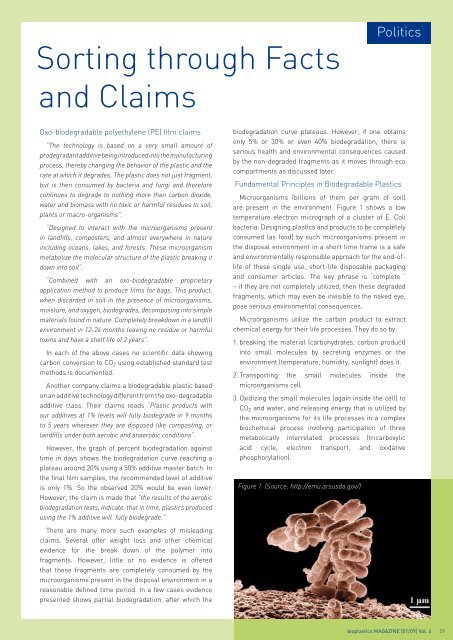bioplasticsMAGAZINE_0901
bioplasticsMAGAZINE_0901
bioplasticsMAGAZINE_0901
You also want an ePaper? Increase the reach of your titles
YUMPU automatically turns print PDFs into web optimized ePapers that Google loves.
Politics<br />
Sorting through Facts<br />
and Claims<br />
Oxo-biodegradable polyethylene (PE) film claims<br />
”The technology is based on a very small amount of<br />
prodegradant additive being introduced into the manufacturing<br />
process, thereby changing the behavior of the plastic and the<br />
rate at which it degrades. The plastic does not just fragment,<br />
but is then consumed by bacteria and fungi and therefore<br />
continues to degrade to nothing more than carbon dioxide,<br />
water and biomass with no toxic or harmful residues to soil,<br />
plants or macro-organisms”.<br />
“Designed to interact with the microorganisms present<br />
in landfills, composters, and almost everywhere in nature<br />
including oceans, lakes, and forests. These microorganism<br />
metabolize the molecular structure of the plastic breaking it<br />
down into soil”.<br />
“Combined with an oxo-biodegradable proprietary<br />
application method to produce films for bags. This product,<br />
when discarded in soil in the presence of microorganisms,<br />
moisture, and oxygen, biodegrades, decomposing into simple<br />
materials found in nature. Completely breakdown in a landfill<br />
environment in 12-24 months leaving no residue or harmful<br />
toxins and have a shelf life of 2 years”.<br />
In each of the above cases no scientific data showing<br />
carbon conversion to CO 2 using established standard test<br />
methods is documented.<br />
Another company claims a biodegradable plastic based<br />
on an additive technology different from the oxo-degradable<br />
additive class. Their claims reads “Plastic products with<br />
our additives at 1% levels will fully biodegrade in 9 months<br />
to 5 years wherever they are disposed like composting, or<br />
landfills under both aerobic and anaerobic conditions”.<br />
However, the graph of percent biodegradation against<br />
time in days shows the biodegradation curve reaching a<br />
plateau around 20% using a 50% additive master batch. In<br />
the final film samples, the recommended level of additive<br />
is only 1%. So the observed 20% would be even lower.<br />
However, the claim is made that “the results of the aerobic<br />
biodegradation tests, indicate, that in time, plastics produced<br />
using the 1% additive will fully biodegrade.”<br />
There are many more such examples of misleading<br />
claims. Several offer weight loss and other chemical<br />
evidence for the break down of the polymer into<br />
fragments. However, little or no evidence is offered<br />
that these fragments are completely consumed by the<br />
microorganisms present in the disposal environment in a<br />
reasonable defined time period. In a few cases evidence<br />
presented shows partial biodegradation, after which the<br />
biodegradation curve plateaus. However, if one obtains<br />
only 5% or 30% or even 40% biodegradation, there is<br />
serious health and environmental consequences caused<br />
by the non-degraded fragments as it moves through eco<br />
compartments as discussed later.<br />
Fundamental Principles in Biodegradable Plastics<br />
Microorganisms (billions of them per gram of soil)<br />
are present in the environment. Figure 1 shows a low<br />
temperature electron micrograph of a cluster of E. Coli<br />
bacteria. Designing plastics and products to be completely<br />
consumed (as food) by such microorganisms present in<br />
the disposal environment in a short time frame is a safe<br />
and environmentally responsible approach for the end-oflife<br />
of these single use, short-life disposable packaging<br />
and consumer articles. The key phrase is ‘complete ‘<br />
– if they are not completely utilized, then these degraded<br />
fragments, which may even be invisible to the naked eye,<br />
pose serious environmental consequences.<br />
Microorganisms utilize the carbon product to extract<br />
chemical energy for their life processes. They do so by:<br />
1. breaking the material (carbohydrates, carbon product)<br />
into small molecules by secreting enzymes or the<br />
environment (temperature, humidity, sunlight) does it.<br />
2. Transporting the small molecules inside the<br />
microorganisms cell.<br />
3. Oxidizing the small molecules (again inside the cell) to<br />
CO 2 and water, and releasing energy that is utilized by<br />
the microorganisms for its life processes in a complex<br />
biochemical process involving participation of three<br />
metabolically interrelated processes (tricarboxylic<br />
acid cycle, electron transport, and oxidative<br />
phosphorylation).<br />
Figure 1 (Source: http://emu.arsusda.gov/)<br />
bioplastics MAGAZINE [01/09] Vol. 4 29


















